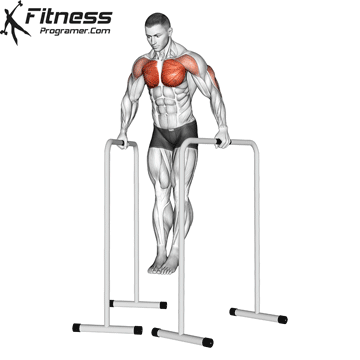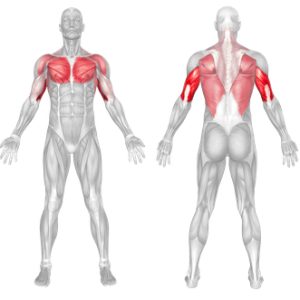Parallel Bar Dips Overview
Parallel Bar Dips are a highly effective bodyweight exercise targeting the chest, triceps, and shoulders. By adjusting your posture, you can emphasize either the chest or triceps. Leaning forward focuses more on the chest, while maintaining an upright position shifts the emphasis to the triceps. It is an ideal option for those who want to improve upper body strength or master calisthenic exercises.
How to Perform Parallel Bar Dips

Setup
- Position yourself between the parallel bars.
- Grip the bars firmly with your palms facing inward.
- Lift your body off the ground, supporting your weight with your arms.
Execution
Chest-Focused Dips:
- Slightly lean your torso forward with your chin tucked and legs bent backward.
- Lower your body by bending your elbows, keeping them flared outward at about a 45-degree angle.
- Stop when your upper arms are parallel to the ground or slightly below.
- Push yourself back up to the starting position by straightening your arms.
Triceps-Focused Dips:
- Keep your torso upright with your legs straight beneath you.
- Lower your body by bending your elbows, keeping them close to your sides.
- Stop when your upper arms are parallel to the ground.
- Push yourself back up to the starting position.
Tips for Maximum Effectiveness
- Adjust Your Lean: Forward lean targets the chest; upright posture emphasizes the triceps.
- Control the Tempo: Slow and controlled movements improve muscle engagement and prevent injury.
- Warm Up Properly: Mobilize your shoulders and wrists to prepare for the range of motion required.
- Use Assistance if Necessary: Beginners can use resistance bands or an assisted dip machine to build strength.
- Incorporate Progressions: Add weight with a dip belt or perform explosive dips to increase intensity.
Common Mistakes to Avoid
- Lack of Full Range of Motion: Avoid shallow dips; lower your body until your upper arms are parallel to the ground.
- Flaring Elbows Excessively: Keep elbows at about a 45-degree angle for chest dips and close to your sides for triceps dips.
- Swinging or Jerky Movements: Perform the exercise with controlled motions to maximize muscle activation and reduce injury risk.
- Overarching the Lower Back: Engage your core to maintain a neutral spine throughout the movement.
- Ignoring Joint Pain: Stop if you feel discomfort in your shoulders or wrists and modify the exercise as needed.
Benefits of Parallel Bar Dips
- Upper Body Strength
- Builds strength in the chest, triceps, and shoulders, essential for pressing motions.
- Chest Development
- Focuses on the lower chest, adding shape and definition to the pectoral muscles.
- Triceps Growth
- Excellent for isolating and building strong, well-defined triceps.
- Functional Strength
- Enhances performance in everyday pushing movements and sports-specific actions.
- Scalability
- Can be modified with assistance bands for beginners or added weight for advanced lifters.
- Core Engagement
- Activates the core for balance and stability, improving overall functional fitness.
- Minimal Equipment Needed
- Requires only parallel bars, making it accessible and convenient.
Parallel Bar Dips Muscles Worked

